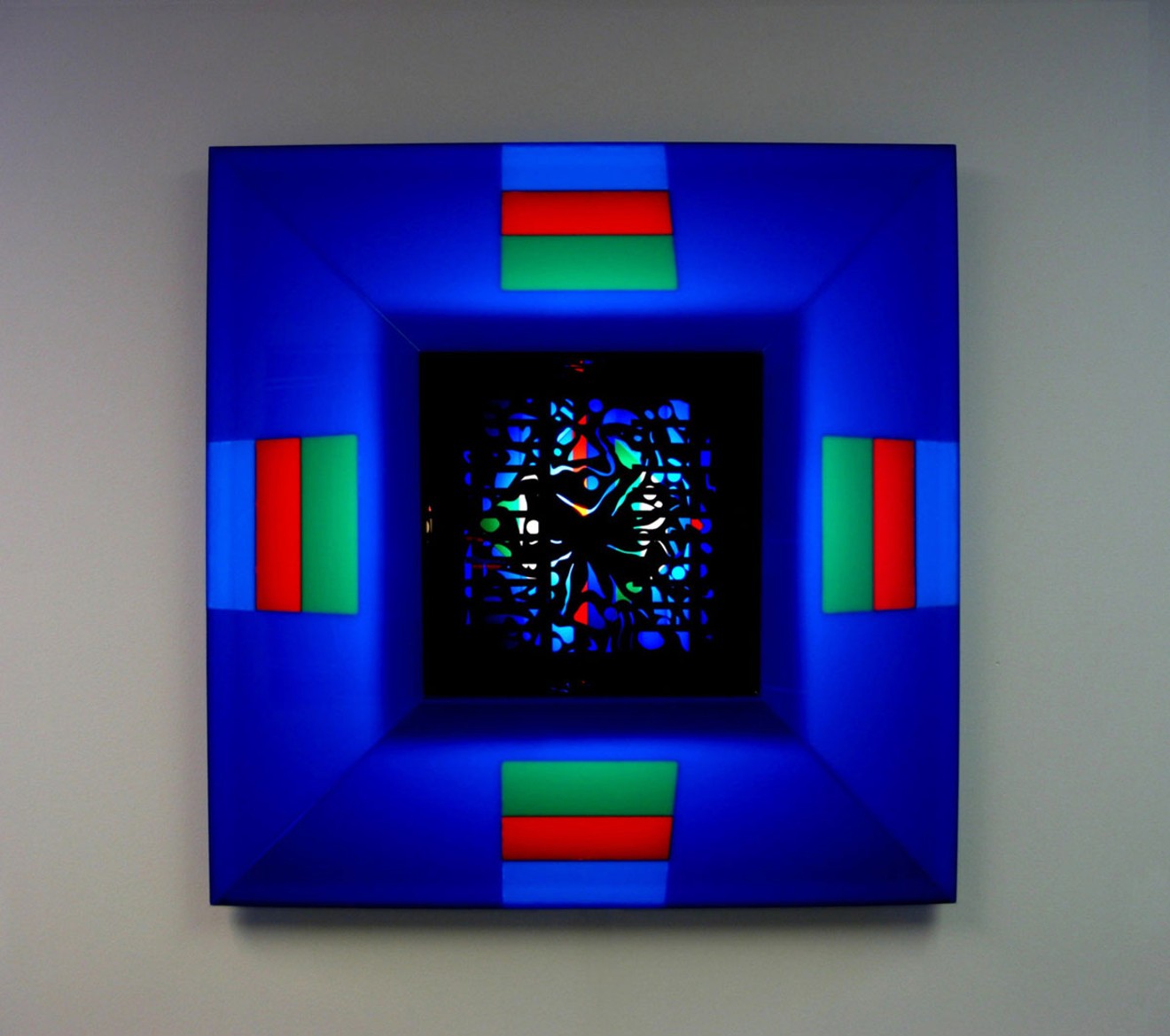The eye-dazzling yet somehow relaxing Lumonics Then & Now: A Retrospective of Light-Based Sculpture by Dorothy & Mel Tanner transforms the interior galleries of the Museum of Outdoor Arts into a world of their own. The spotlights have been dimmed so that the exhibit’s internally lighted transparent acrylic sculptures and wall panels, as well as its projected videos, can glow gently in the near-darkness. A soft electronic soundtrack composed by Dorothy Tanner and her longtime collaborator, Marc Billard, adds yet another soothing aspect to the exhibit.
The Tanners were already established artists in 1969 when Mel had what Dorothy calls “an epiphany.” At the time, he was creating abstract paintings and she was doing abstract sculptures. Mel’s breakthrough was the realization that they should add light and sound — and, in the early years, performance — to their conjoined practices, and Dorothy readily embraced the idea. One of the first pieces Mel did along these lines is included in the MOA show. The untitled work takes the shape of a vertically oriented dark-plastic rectangle with a lighted circle surrounded by a meandering halo in the top half; below, an “x” shape shines through its edges. The piece looks so fresh, it could have been done yesterday rather than nearly fifty years ago.
The sculptures and wall panels created since then by Mel and Dorothy individually take on a staggering array of forms, many evocative of a sci-fi spaceship or a flashy disco of the future. At first glance, it’s hard to distinguish Dorothy’s style from Mel’s — until you notice that she’s much more expressionistic, while he’s more strictly geometric. Barry Raphael, a member of the Lumonics Studio group that the Tanners founded, explains that while Mel worked from sketches, Dorothy worked directly with the materials. In either case, the craftsmanship is meticulous, and as I walked through the show, I was astounded by how beautifully everything was made.
Mel and Dorothy were up to their necks in the counterculture, vegetarians who smoked pot and were into meditation, and the Lumonics Studio was a commune that moved around the country, from Florida to California to Maine and back to Florida again. After Mel died, in 1993, Dorothy continued working with light and sound. In 2008, Dorothy and the other surviving members of the Lumonics group — Billard, Raphael and Barbara Ungar — moved to Denver. Today, at 94, Dorothy is still active in her studio.
The MOA exhibit represents the first-ever retrospective anywhere for both Lumonics and Dorothy and Mel Tanner, and it is spectacular. Lumonics Then & Now runs through March 24 at the Museum of Outdoor Arts in the Englewood Civic Center, 1000 Englewood Parkway. For more information, call 303-806-0444 or go to moaonline.org.
[
{
"name": "Air - MediumRectangle - Inline Content - Mobile Display Size",
"component": "12017618",
"insertPoint": "2",
"requiredCountToDisplay": "2"
},{
"name": "Editor Picks",
"component": "17242653",
"insertPoint": "4",
"requiredCountToDisplay": "1"
},{
"name": "Inline Links",
"component": "18838239",
"insertPoint": "8th",
"startingPoint": 8,
"requiredCountToDisplay": "7",
"maxInsertions": 25
},{
"name": "Air - MediumRectangle - Combo - Inline Content",
"component": "17261320",
"insertPoint": "8th",
"startingPoint": 8,
"requiredCountToDisplay": "7",
"maxInsertions": 25
},{
"name": "Inline Links",
"component": "18838239",
"insertPoint": "8th",
"startingPoint": 12,
"requiredCountToDisplay": "11",
"maxInsertions": 25
},{
"name": "Air - Leaderboard Tower - Combo - Inline Content",
"component": "17261321",
"insertPoint": "8th",
"startingPoint": 12,
"requiredCountToDisplay": "11",
"maxInsertions": 25
}
]















